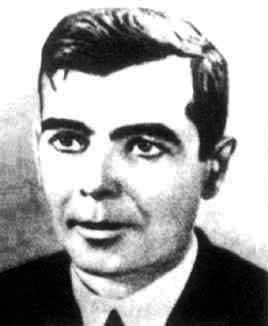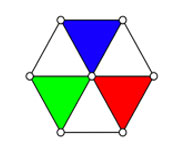


 تاريخ الرياضيات
تاريخ الرياضيات
 الرياضيات في الحضارات المختلفة
الرياضيات في الحضارات المختلفة 
 الرياضيات المتقطعة
الرياضيات المتقطعة
 الجبر
الجبر
 الهندسة
الهندسة 
 المعادلات التفاضلية و التكاملية
المعادلات التفاضلية و التكاملية 
 التحليل
التحليل
 علماء الرياضيات
علماء الرياضيات |
Read More
Date: 14-11-2017
Date: 14-11-2017
Date: 29-10-2017
|
Died: 10 March 1981 in Donetsk, USSR

Yaroslav Borisovich Lopatynsky (or Lopatinskii) attended Baku State University in Baku, the capital of Azerbaijan, graduating in 1926. He continued to study at the graduate school of the university but in 1930 higher education was reorganised in Azerbaijan and Baku State University became the Supreme Pedagogical Institute. However, in 1934 the university was reestablished. Also as part of the reorganisation, Azerbaijan State Economic University was founded in Baku in 1930. Lopatynsky worked at both the Azerbaidzhan University and the Baku Polytechnic Institute. The Polytechnic Institute had been called the Baku Polytechnicum from its founding in 1887 until the Red Army took control of Baku in 1920 when the Baku Polytechnicum became the Baku Polytechnic Institute.
Lopatynsky's first papers were on analysis: On uniform convergence (1929); Embedding of a Riemannian space in a Euclidean space (1934); (with L P Fridolina) The justification of mathematics, a critical situation (1934); and Limiting values of an analytic function on a set of singular points of measure greater than zero on a rectified curve (1935). He was awarded a Master's degree by Kharkov University in 1938 without having to write a thesis. His research interests then moved towards differential equations with his first paper on this topic Solution of the equation y ' = f (x, y) published in 1939, proving a general existence theorem.
During World War II, Lopatynsky continued to teach at the Azerbaidzhan University and the Baku Polytechnic Institute. He continued to undertake research on differential equations, but his interests now included differential operators. In 1945 he published Linear differential operators. Oscar Zariski begins a review of the paper by writing:-
The author studies linear (partial) differential equations from a formal algebraic point of view. His treatment of this special case of the algebraic theory of algebraic differential equations yields a well-rounded ideal theory of linear differential operators; in many respects it differs essentially from the treatment due to Ritt (for instance, ideals and sums of integral manifolds are defined differently).
In 1945 Lopatynsky moved to Lvov where he was appointed to the chair of differential equations at Lvov University. In addition, he worked at the Institute of Mathematics in Lvov which was part of the Ukrainian Academy of Sciences of the SSR. He submitted his doctoral dissertation, dealing with an algebraic theory of rings of differential operators, to Moscow University, and he defended his thesis in 1946. His seminar on differential equations at Lvov University attracted many mathematicians, both young men beginning their research activity and established researchers who found inspiration in the seminar. Lopatynsky's research continued to impress as he continued to prove major results in the theory of systems of linear differential equations of the elliptic type. In 1963 he left Lvov and moved to Moscow's Industrial Institute. In 1966 he became head of the partial differential equations Section of the Institute of Applied Mathematics and Mechanics of the Academy of Sciences of the Ukraine in Donetsk. He was also appointed as Chairman of the Department of Differential Equations at Donetsk University.
Lopatynsky's contributions to the theory of differential equations are particularly important, with important contributions to the theory of linear and nonlinear partial differential equations. He worked on the general theory of boundary value problems for linear systems of partial differential equations of elliptic type, finding general methods of solving boundary value problems. In Donetsk [8]:-
... he continued his studies of general boundary problems in differential equations using topological methods. His work opened up broad possibilities for applying Morse theory to variational elliptic problems. Recently he has obtained important results on solvability of the Cauchy problem for operator equations in Banach space and also on "almost everywhere" solvability of general linear and nonlinear boundary problems.
Volodymyr Petryshyn writes in [5]:-
Lopatynsky was the first person to formulate a condition on the relation between the coefficients of the system and the coefficients of the boundary operators which is necessary and sufficient for the normal solvability of boundary value problems. This is now known as the Lopatynsky Condition. He also obtained some basic results in the solvability of the Cauchy problem for operator equations in Banach spaces.
In 1980 Lopatynsky published an important book Introduction to the Contemporary Theory of Partial Differential Equations. He writes in the Introduction:-
This book makes the reader familiar with the basic notions and facts of algebra, topology, and functional analysis, and gives a general idea how to apply these notions to the theory of differential equations. Only a minor part of the proofs is sketched. More detailed presentations can be found in many monographs on topology and functional analysis which will be cited systematically in this text.
The book contains eight chapters: Sets; Basic algebraic notions; Algebraic equations; Topology; Differentiation and integration; Special linear spaces which are related to Euclidean spaces; Manifolds; and Elements of algebraic topology.
His next book, published in 1984 three years after his death, was entitled Ordinary differential equations. He writes in the Introduction:-
We consider the basic methods of solving differential equations and methods of qualitative investigation of these solutions. We emphasize the relation of the theory of differential equations to other areas of mathematics. We illustrate the theoretical material with an analysis of the solution of many examples. The text is for university students in mathematical specialties.
As to his character the authors of [1] write:-
Lopatinskii is a highly cultured human being, a great connoisseur of both Russian classical and foreign literature and a fine judge of art, of painting in particular. His modesty and the high standards that he sets for himself, his attentiveness and straightforwardness in dealing with others, and his constant readiness to be of assistance when needed make any association with him an enlightening and delightful experience. Yaroslav Borisovich has won the deep admiration and respect of his many students, as well as those closely associated with him professionally and socially.
Lopatynsky received many honours for his achievements. He was elected a corresponding member of the Ukrainian Academy of Sciences of the SSR in 1951, being elected a full member in 1965. He received the Ukraine State Prize in science and engineering in 1978. He was also awarded the Order of Lenin, the Order of the October Revolution, and various medals. In addition a book Theory of general boundary value problems was published in 1984 containing a selection of 35 of his papers from the total of 59. Finally let us mention that the Second International Conference for young mathematicians on Differential Equations and Applications held in November 2008 at the Donetsk National University was dedicated to Ya B Lopatinskii. The organisers write that their aims are:-
Bringing together young and some venerable researchers in above areas in order to get acquainted, to communicate and to understand what directions are actual and perspective. The word "young" in the title means a general direction of the conference but doesn't mean any age limitations for the participants. The conference is named after an outstanding mathematician, talented pedagogue and organiser, Academician of National Academy of Sciences of Ukraine Yaroslav Borisovich Lopatinskii who was a founder of both the Department of Differential Equations in Donetsk National University and the Department of Partial Differential Equations in the Institute of Applied Mathematics and Mechanics of National Academy of Sciences of Ukraine. The conference is the continuation of the Conference on Differential Equations and Applications dedicated to the centenarian jubilee of Ya B Lopatinskii held in December 2006.
Articles:



|
|
|
|
التوتر والسرطان.. علماء يحذرون من "صلة خطيرة"
|
|
|
|
|
|
|
مرآة السيارة: مدى دقة عكسها للصورة الصحيحة
|
|
|
|
|
|
|
نحو شراكة وطنية متكاملة.. الأمين العام للعتبة الحسينية يبحث مع وكيل وزارة الخارجية آفاق التعاون المؤسسي
|
|
|